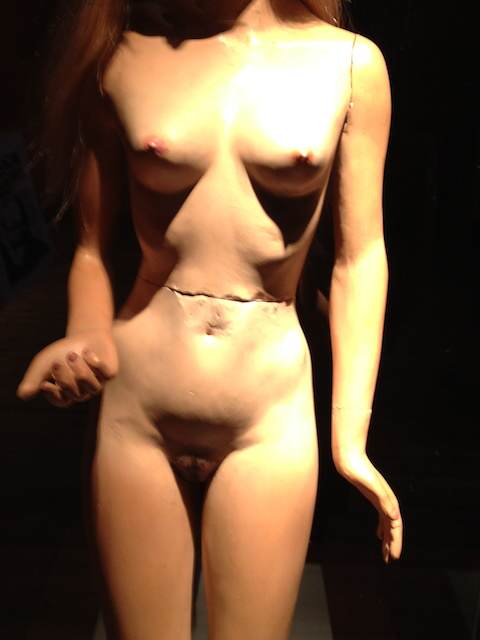CINDY SHERMAN
CINDY SHERMAN

[vc_row][vc_column][vc_single_image image=”3583″ img_size=”full”][/vc_column][/vc_row][vc_row][vc_column][vc_empty_space height=”50px”][vc_column_text]The Vivisector
Cindy Sherman (group show)
Curated by Todd Levin
Sprueth-Magers Gallery
7 Grafton Street, W1S 4EJ
till January 26 2013
photos:nathalie hambro
The Vivisector, investigates two bodies of work by Cindy Sherman: the photographic series ‘Sex Pictures’ (1989-1992) in which the artist examined the body through mannequins and prosthetics, and a subsequent series of black and white images entitled ‘Broken Dolls’ (1999), depicting dismembered and reconstructed figurines. The exhibition will contextualise and re-evaluate the importance of these specific series in Sherman’s oeuvre. While Sherman’s compositions are the cynosure of this exhibition, work by artists including Morton Bartlett, Georges Bataille, Hans Bellmer, Bruce Nauman and Frederick Sommer also be on display, illustrating a collective interest in the transgressive figurative form. In addition, “Les oiseaux dans la charmille” (also known as “The Doll Song”) from Jacques Offenbach’s opera ‘The Tales of Hoffmann’ provides a musical backdrop to the exhibition, recounting the story of a poet who is deceived into falling in love with a mechanical doll.
The title of the exhibition refers to the act of cutting open a living organism for physiological or pathological investigation. The idea of opening up and exposing a living body is central to Sherman’s practice, particularly evident in the base materialism of these unflinching effigies. In the ‘Sex Pictures’ Sherman, for the first time, delegates her role in her imagery to dolls and dummies, masked and manipulated to resemble living beings. The colour images focus in on the incomplete object, whether it be genitalia or scattered limbs, and alternate between obscene visions of the body and straightforward illustrations of specific practices, crippling the drive of sexual desire in the process.
The latter series ‘Broken Dolls’ created in 1999 marked the artist’s first return to black and white photography since theUntitled Film Stills of 1978-1980. The low contrast matte grey and washed out refracted light of the photographs imbue the works with a soft romantic appearance, juxtaposing the harsh sexual imagery. Through melting and cutting, Sherman dismembers and reconstructs the mutilated dolls in violent and sexually explicit poses; the doll depicted in ‘Untitled #347’ distorts in the grip of pain or pleasure, while in ‘Untitled #335’ the figure offers itself to the viewer in an obscene stance, implying an autonomous participation in the scenes depicted.
A posthumously discovered body of work by professional commercial photographer Morton Bartlett (1909-1992) draws parallels with Sherman’s images of prosthetic figures. Bartlett created his dolls from scratch; half life-size and anatomically accurate, they are technically sophisticated and often dressed in meticulously hand sewn clothes. Like Sherman, Bartlett photographed his creations in staged scenarios, alternating between expressions of childlike innocence and the portrayal of seductive poses, implicating the dolls in the role of fetishes or substitutes for unknowable desires.
The images of dolls on display in the exhibition underline the Surrealist fascination with automata, due in particular to the uncanny dread produced by their dubious animate/inanimate status. While Bartlett’s ‘Untitled (Standing Girl)’, c.1950-60, is representative of a real child, ‘We Follow Her with Slow Steps’ (1937) by the surrealist photographer Hans Bellmer again depicts a manipulated female figure deprived of limbs, consisting of a head and shoulders with a mask-like face and numerous breasts. An ideal Surrealist object because of its conjunction of desire and revolt, the image coincides with the Surrealist idealization of the femme-enfant, a muse whose association with dual realms of alterity, femininity and childhood, inspired male artists in a revolt against the rational.
The Surrealists also accorded great importance to tribal art such as African sculpture and masks, recognizing in them a highly sophisticated abstraction and distortion which confirmed their own ideas about form and structure. The exhibition includes a tribal sculpture from Cameroon; a standing figure, arms bound, with a ferocious shell encrusted mask. In Frederick Sommer’s ‘Valise d’Adam’ (1949), the configuration of incongruous items such as a doll and shells suggests a dramatic, totemic figure from a lost civilization. The work reveals the photographer’s belief that things which at first might not appear to have anything in common can unite and create an unexpected relatedness we both recognize and question. By positioning the camera directly above these precisely observed and arranged found objects, Sommer transformed their everyday quality into pictorial elements of drama and power.
The Surrealist fascination with tribal culture is evident in the secret society and periodical entitled “Acéphale”, established by George Bataille in 1936. On display are vintage issues of the periodical that feature an illustration by André Masson of a beheaded man, referencing the title which derives from the Greek terminology for ‘headless’. Notions of disembodiment are explored further in Bruce Nauman’s ‘Double Poke in the Eye II’ (1985), a sequentially timed, multi-coloured, neon wall sculpture featuring two disconnected human heads poking each other in the eye. The work belongs to a series of large format neons centered on themes of sex and violence, which Nauman developed in 1985. It has a comical element, with the pair taking it in turns to poke at each other as the neon light alternates, caught in an endless back-and-forth of mindless aggression.[/vc_column_text][/vc_column][/vc_row][vc_row][vc_column][vc_empty_space height=”50px”][vc_single_image image=”3584″ img_size=”full”][vc_empty_space height=”50px”][vc_single_image image=”3585″ img_size=”full”][vc_empty_space height=”50px”][vc_single_image image=”3586″ img_size=”full”][vc_empty_space height=”50px”][vc_single_image image=”3587″ img_size=”full”][vc_empty_space height=”50px”][vc_single_image image=”3588″ img_size=”full”][vc_empty_space height=”50px”][vc_single_image image=”3589″ img_size=”full”][vc_empty_space height=”50px”][/vc_column][/vc_row][vc_row][vc_column][vc_column_text css_animation=”none” el_class=”with-link”]![]() back to ART DIARY[/vc_column_text][/vc_column][/vc_row]
back to ART DIARY[/vc_column_text][/vc_column][/vc_row]

Comments are closed.